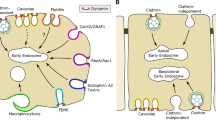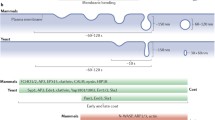Abstract.
Potocytosis represents a mechanism by which small and large molecules as well as macromolecular complexes are sequestered and transported by caveolae. Caveolae are flask-shaped plasma membrane specializations characterized by a filamentous coat consisting of caveolins that decorates the inside surface of each caveola membrane. They have endocytotic functions that differ from the clathrin-coated pit pathway. Ligands bound to receptors that are internalized by caveolae can be delivered to four different locations in the cell bypassing the lysosome and at least four different caveolae membrane traffic patterns during potocytosis can be distinguished. Hence, cells have two endocytic machines and each is designed to accomplish different tasks. This review provides a brief summary of the discovery of caveolae and of potocytosis, and focuses on recent discoveries of the unique endocytic capabilities of caveolae in a variety of different cells.
Similar content being viewed by others
Author information
Authors and Affiliations
Additional information
Electronic Publication
Rights and permissions
About this article
Cite this article
Mineo, C., Anderson, R.G. Potocytosis. Histochem Cell Biol 116, 109–118 (2001). https://doi.org/10.1007/s004180100289
Accepted:
Issue Date:
DOI: https://doi.org/10.1007/s004180100289




